Advanced Technology
Consultants |
home | help | email |
Welcome to

Advanced Technology Consultants
Laguna Niguel, California
USA 92677
Tel: 949 467 9233
(001 prefix outside USA)
Lugano, Ticino
Switzerland 6900
| Research & Development Management |
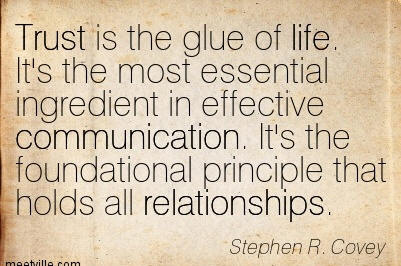 |
|
Effective Management of R&D Teams and Organizations
In today's technology-driven
global economy, innovation is at the core of the
survival-of-the-fittest organization.
Managing R&D organizations and concentrating on their productivity and excellence offers a unique set of problems and unusual challenges that are amplified when the team is scattered spatially in a global economy. This uniqueness arises primarily from two basic facts: (1) the character of the enterprise, and (2) the highly-specialized, articulate, and autonomous people involved in R&D. As American economist and Nobel laureate Kenneth J. Arrow stated, "The central economic fact about the processes of invention and research is that they are devoted to the production of information." Obviously, the generation of information requires research and, in addition to the R&D organizations' focus on information, research involves considerable uncertainty because the outcome can never be predicted perfectly from the different inputs used. It will, therefore, become clear in this course that managing an R&D organization is largely the art of integrating the efforts of diverse, creative, intelligent, and independent individuals. The ideas presented in this course consist of the condensed works of a multitude of experts focusing on ways to improve the productivity of R&D and foster excellence and innovation in organizations.
The course is intended for all levels of managers, supervisors, and team/group leaders who wish to improve their leadership, management, motivational, and communication skills for creating optimum individual and team performance in R&D organizations. It is particularly useful to scientists, engineers, project managers, and other technical personnel who intend to make a transition to management positions in an R&D environment or who want to improve their own leadership and/or followership skills. It also is beneficial for faculty members, group leaders, department heads, research administrators, managers responsible for sponsoring research, and policy makers in science and technology.
Electronic and hard copies of the seminar materials can be purchased and are only available through ATC. Contact ATC for price and shipping.
NOTE: Professionally-prepared "audio-video Powerpoint-type presentations" of these seminars are available for purchase by the companies. Each slide is presented with a clear audio by the consultant, describing the subject, while a digital pointer guides the audience to where the attention is to be focused. Companies can put such audio-video presentations on their intranet to be used by their employees. It is a cost effective way of approaching professional training which also contributes towards R&D, design, and intelligent new product development. Presentations are updated every year at a fraction of the original cost. For a sample presentation click on the word "R&D" in the picture to get a feel of how information is transferred (High-speed internet access is recommended. Otherwise, download may take a few more minutes). The actual copy sold is of high resolution with high quality sound. For more details and pricing please contact ATC.
How to Arrange for a
Presentation: Individuals who are interested in this seminar should contact Advanced Technology Consultants (ATC) directly. Due to ATC's low overhead, direct-contact clients are offered a competitive and cost-effective package. Alternatively, you can contact American Society of Mechanical Engineers (ASME) website for schedule and registeration. This course was initially prepared for the University of California at Los Angeles (UCLA) and subsequently offered by the ASME.
Upon completing this course, participants should:
Daily Schedule "One man's research is another man's routine", Prof. Antoni K. Oppenheim
FIRST DAY: R&D Organizations and Research Classification ∑ What is research and development? ∑ Basic or applied research ∑ Unique issues in R&D management
Components Required for R&D Organizations ∑ Staff, ideas, communication, funds, culture ∑ The match of a person and the job
Creating Effective and Productive R&D Organizations ∑ Organization effectiveness ∑ Specific characters of inventors/innovators ∑ Management, researcher, and peer relationships ∑ Group/team formation ∑ Ethos of a scientific community
SECOND DAY: Motivation in an R&D Environment ∑ A human behavior model ∑ Reward system and its change to sustain and support scientific/technical careers ∑ Organizational structure for optimum communication
Leadership and Issues in R&D Organizations ∑ Leadership styles ∑ Leadership in R&D organizations: mutual influence process ∑ A leadership style case study
THIRD DAY: Technology Transfer Issues ∑ Technology transfer stages ∑ Innovation ∑ Role of people and market ∑ Organizational issues in technology transfer ∑ Strategies ∑ A case study
Strategic Planning for R&D Organizations ∑ Strategy in the context of a corporation
∑
Technology strategy
∑ Strategic planning ∑ Strategic thinking and management ∑ An example of a strategic plan
New product development
R&D portfolio management & optimization
Technology roadmapping, economic forecasting, and investment opportunities
Disruptive technologies and their evaluations
Case Studies and Discussion (numerous throughout the seminar) ∑ From Harvard Business Review (HBR)
Summary and Conclusions
Note: for best outcome and maximum
absorption, it is recommended that the above topics are covered
in 4 days to allow ample time
LecturerS: Dr. Chehroudi assisted by M. Hooshmand
Dr.
Chehroudi, has accumulated years of
technical and leadership experiences in different capacities
and organizations. This includes such positions as a
Principal Scientist and Group Leader appointment at the Air
Force Research Laboratory (AFRL) ERCInc, a Chief Scientist
at Raytheon STX, a Visiting Technologist at Fordís Advanced
Manufacturing Technology Development (AMTD) center, a
tenured Professor of Mechanical Engineering at Kettering
University and University of Illinois, and served as a
Senior Research Staff/Research Fellowship at Princeton
University. Dr. Chehroudi directed numerous multimillion
dollar interdisciplinary projects in areas involving
chemically reacting flows, combustion and emission of
pollutants, sustainable and alternative energy
For M. Hooshmand's short biography click on her name: Hooshmand Bio
NOTE: Contact Advanced Technology Consultants for consulting needs and opportunities in this area. Copyright 2017 - Advanced Technology Consultants- All Rights Reserved |
|
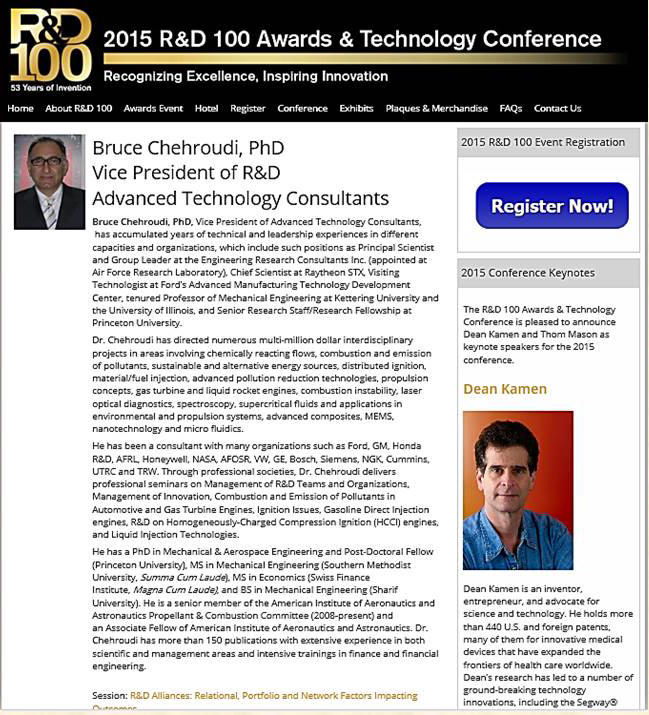
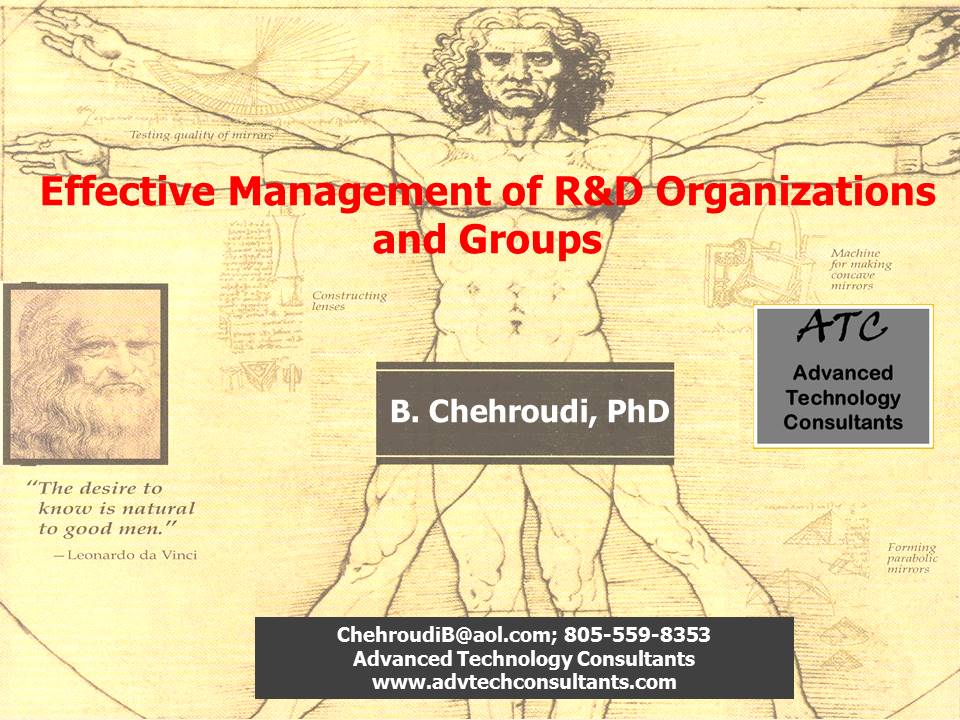
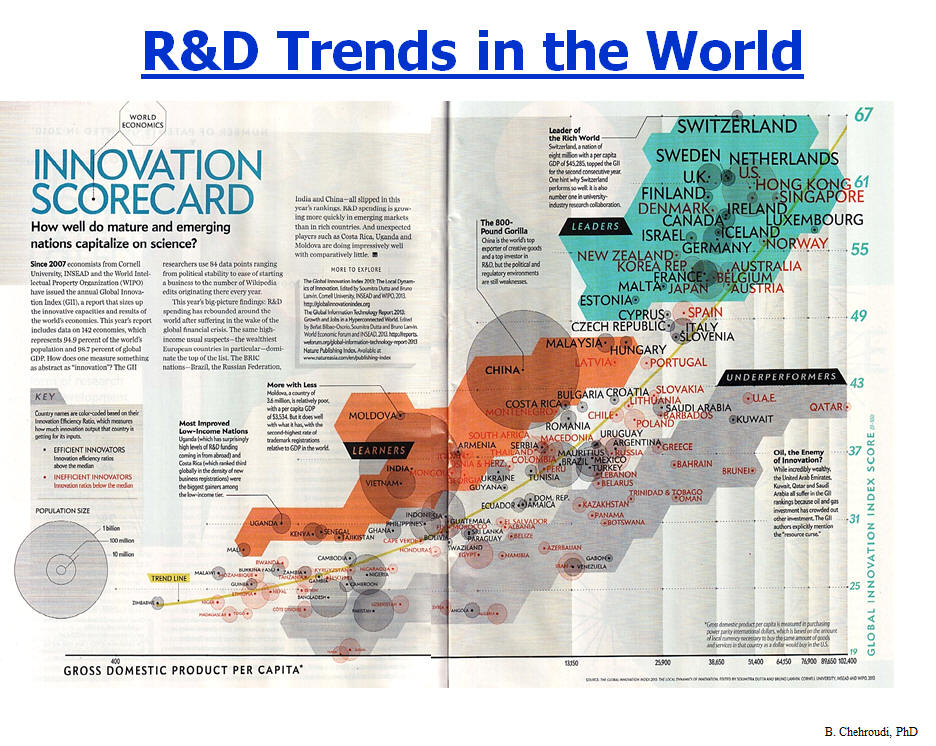
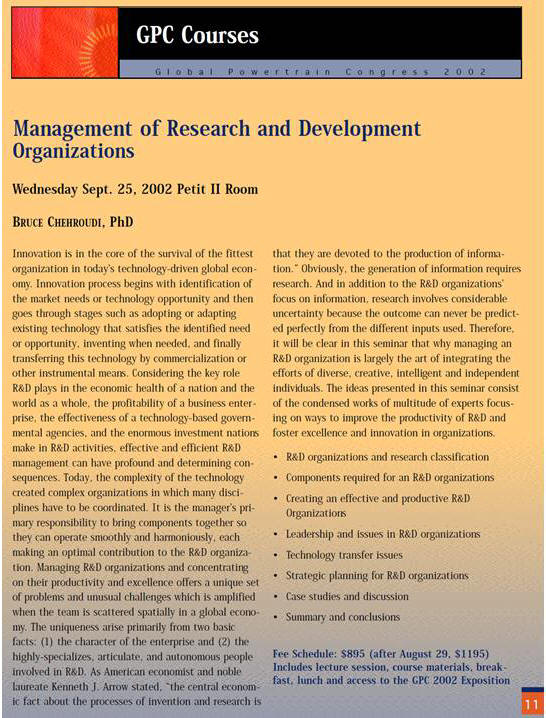 sources,
distributed ignition, material/fuel injection, advanced
pollution reduction technologies, propulsion concepts, gas
turbine and liquid rocket engines, combustion instability,
laser optical diagnostics, spectroscopy, supercritical
fluids and applications in environmental and propulsion
systems, advanced composites, MEMS, nanotechnology, and
micro fluidics. He has won many merit and leadership awards
by such prestigious organizations as the Society of
Automotive Engineers (1. Arch. T. Colwell Merit Award
for technical excellence only to top 1% yearly, 2. Ralph
R. Teetor Award for outstanding
teaching/research/leadership, 3. Forest R. McFarland
Award for sustained leadership in professional and
educational service and a key contributor to the Continuing
Professional Development Group, 4. Appreciation Award for 10
years of dedicated and inspiring service and
commitment to providing quality technical education, and
5. Outstanding Faculty Advisor),
American Institute of Aeronautics and Astronautics (Best
Publication Award of the Year), Air Force Research
Laboratories (1. Outstanding Technical Publication Award,
and 2. STAR Team Award for demonstrating world-class
combined scientific and leadership achievements), Institute
of Liquid Atomization and Sprays Systems (Marshall Award
for best publication with lasting contributions), Liquid
Propulsion Sub-committee of Joint Army-Navy-NASA-Air Force (JANNAF)
(Best Liquid Propulsion Paper Award involving
undergraduate/graduate students), and the 2nd
International Symposium on Turbulence and Shear Flow
Phenomena (Top 10 Technical Publication Award). He has been a consultant
with many organizations such as, Ford, GM, Honda R&D, AFRL,
Honeywell, NASA, AFOSR, VW, Bosch, Siemens, NGK, Cummins,
and TRW. Through professional societies, Dr. Chehroudi
delivers invited professional seminars on Management of R&D
Teams and Organizations, Management of Innovation,
Combustion and Emission of Pollutants in Automotive and Gas
Turbine Engines, Ignition Issues, Gasoline Direct Injection
engines, R&D on Homogeneously-Charged Compression Ignition (HCCI)
engines, and Liquid Injection Technologies. He has a PhD in
Mechanical & Aerospace Engineering and Post-Doctoral Fellow
(Princeton University), MS in Mechanical Engineering
(Southern Methodist University, Summa Cum Laude), MS
in Economics (Swiss Finance Institute, Magna Cum Laude),
a senior member of American Institute of Aeronautics and
Astronautics Propellant & Combustion Committee
(2008-present), and is an Associate Fellow of American
Institute of Aeronautics and Astronautics. Dr. Chehroudi
acts as a reviewer for many scientific and engineering
journals and publishers, has delivered over 200
presentations in technical meetings and to nontechnical
audiences, over 20 technical reports (Princeton University,
General Motors, Ford Motor Co, Department of Energy, NASA,
Air Force Research Laboratory), five 600-plus-page monographs on
combustion and emission of pollutants from mobile power
plants, ignition technologies, liquid material injection, and
nanotechnology, two book chapters on propulsion system
combustion instability and applications of graphene (a
nanotech product) in ignition and combustion of fuels,
ground-breaking patents on applications and synergy between
nanotechnology, light, and chemical reaction for a
light-activated distributed ignition of fuel-air mixtures, and
has more than 150 publications with extensive experience in both
scientific and management areas and intensive trainings in
finance and financial engineering
sources,
distributed ignition, material/fuel injection, advanced
pollution reduction technologies, propulsion concepts, gas
turbine and liquid rocket engines, combustion instability,
laser optical diagnostics, spectroscopy, supercritical
fluids and applications in environmental and propulsion
systems, advanced composites, MEMS, nanotechnology, and
micro fluidics. He has won many merit and leadership awards
by such prestigious organizations as the Society of
Automotive Engineers (1. Arch. T. Colwell Merit Award
for technical excellence only to top 1% yearly, 2. Ralph
R. Teetor Award for outstanding
teaching/research/leadership, 3. Forest R. McFarland
Award for sustained leadership in professional and
educational service and a key contributor to the Continuing
Professional Development Group, 4. Appreciation Award for 10
years of dedicated and inspiring service and
commitment to providing quality technical education, and
5. Outstanding Faculty Advisor),
American Institute of Aeronautics and Astronautics (Best
Publication Award of the Year), Air Force Research
Laboratories (1. Outstanding Technical Publication Award,
and 2. STAR Team Award for demonstrating world-class
combined scientific and leadership achievements), Institute
of Liquid Atomization and Sprays Systems (Marshall Award
for best publication with lasting contributions), Liquid
Propulsion Sub-committee of Joint Army-Navy-NASA-Air Force (JANNAF)
(Best Liquid Propulsion Paper Award involving
undergraduate/graduate students), and the 2nd
International Symposium on Turbulence and Shear Flow
Phenomena (Top 10 Technical Publication Award). He has been a consultant
with many organizations such as, Ford, GM, Honda R&D, AFRL,
Honeywell, NASA, AFOSR, VW, Bosch, Siemens, NGK, Cummins,
and TRW. Through professional societies, Dr. Chehroudi
delivers invited professional seminars on Management of R&D
Teams and Organizations, Management of Innovation,
Combustion and Emission of Pollutants in Automotive and Gas
Turbine Engines, Ignition Issues, Gasoline Direct Injection
engines, R&D on Homogeneously-Charged Compression Ignition (HCCI)
engines, and Liquid Injection Technologies. He has a PhD in
Mechanical & Aerospace Engineering and Post-Doctoral Fellow
(Princeton University), MS in Mechanical Engineering
(Southern Methodist University, Summa Cum Laude), MS
in Economics (Swiss Finance Institute, Magna Cum Laude),
a senior member of American Institute of Aeronautics and
Astronautics Propellant & Combustion Committee
(2008-present), and is an Associate Fellow of American
Institute of Aeronautics and Astronautics. Dr. Chehroudi
acts as a reviewer for many scientific and engineering
journals and publishers, has delivered over 200
presentations in technical meetings and to nontechnical
audiences, over 20 technical reports (Princeton University,
General Motors, Ford Motor Co, Department of Energy, NASA,
Air Force Research Laboratory), five 600-plus-page monographs on
combustion and emission of pollutants from mobile power
plants, ignition technologies, liquid material injection, and
nanotechnology, two book chapters on propulsion system
combustion instability and applications of graphene (a
nanotech product) in ignition and combustion of fuels,
ground-breaking patents on applications and synergy between
nanotechnology, light, and chemical reaction for a
light-activated distributed ignition of fuel-air mixtures, and
has more than 150 publications with extensive experience in both
scientific and management areas and intensive trainings in
finance and financial engineering